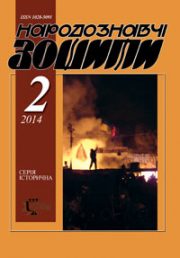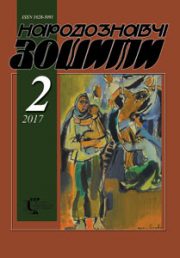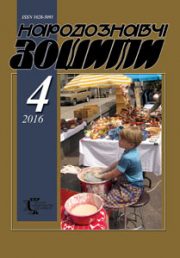The Ethnology Notebooks. 2022. № 6 (168), 1419—1431
UDK [391-055.2:746.1/.3]:069(477.83/.86)”18/195″
DOI https://doi.org/10.15407/nz2022.06.1419
FEMALE PATTERNED SOROCHKAS (SHIRTS) FROM THE PIDHIRIA REGION
NYKORAK Оlena
- ORCID ID: https://orcid.org/0000-0003-0887-8929
- Doctor of Art Studies, professor, Leading Researcher,
- Ethnology Institute of the National Academy of Sciences of Ukraine,
- Folk Art Department,
- 15, Svoboda Avenue, 79000, Lviv, Ukraine,
- Contacts: e-mail: olenanykorak@gmail.com
KUTSYR Tetiana
- ORCID ID: https://orcid.org/0000-0002-6522-0640
- Candidate of Art Studies (Ph. D), Researcher,
- Ethnology Institute of National Academy of Sciences of Ukraine,
- Folk Art Department,
- 15, Svoboda Avenue, 79000, Lviv, Ukraine,
- Contacts: e-mail: sonechko_29@ukr.net
YUSYPCHUK Yurii
- ORCID ID: https://orcid.org/0000-0001-7130-2338
- Candidate of Art Studies (Ph. D), Associate Professor
- Education-Scientific Institute of Art;
- Vasyl Stefanyk Precarpathian National University,
- Department of Visual Arts, Decorative and Applied Arts,
- and Design Methods of Teaching,
- 33/6, Hrushevskui str., Ivano-Frankivsk, Ukraine,
- Contacts: e-mail: yusupchuk@meta.ua
BILYJ Victor
- Candidate of Art Studies (Ph. D), Associate Professor
- Kosiv Institute of Applied and Decorative Art LNAA,
- Department of Fine Art and Academic Disciplines
- 2, Adam Mitskevych str., 78601,
- Kosiv, Ivano-Frankivsk region, Ukraine
- Contacts: e-mail: biluy61@meta.ua
Abstract. In the article, the artistic features of female patterned sorochkas (shirts) from the Pidhiria region are studied. There are only a few references to this phenomenon in the scientific literature available today. The lack of a comprehensive analysis of the most noticeable signs of the originality of the decor of the Pidhiria female patterned shirts determined the relevance and novelty of the study.
The article purpose is to reveal the artistic and stylistic features of the woven and embroidered decor of female patterned shirts from the Pidhiria Region, to find out the basic principles of combining the embellishments, made by various techniques, into one, harmoniously integrated composition.
The research object is the female shirts and the embroidery samples from the Pidhiria Region preserved in the Lviv and Ivano-Frankivsk regions museums, and the subject is the artistic features of their woven and embroidered decor.
The art analysis, structural and comparative methods are the methodological basis of the work. They were used to identify the principles of the composition schemes formation, as well as individual ornamental motifs.
The source base of the research was: professional publications by Ukrainian scientists in the field of traditional weaving and embroidery, as well as material items (shirts and their fragments, including yokes from Klementii Sheptytskyi Museum of Folk Architecture and Rural Life (Lviv), Museum of Ethnography and Applied Arts of Ethnology Institute of the National Academy of Sciences of Ukraine (Lviv), Andrey Sheptytskyi National Museum in Lviv, Stryi Museum of Local History «Verkhovyna», Museum of Zhydachiv Land, and National Museum of Hutsul & Pokuttia Region Folk Art (Kolomyia) collections).
In the article the main types of the female patterned shirts decoration from the Pidhiria Region are distinguished, as well as the variability of composition schemes and color combinations, features of the merger between woven, embroidered, and lace decor have been revealed, and the evolution of compositional schemes and ornament motifs have been traced. In the second half of the XIX century, the main decoration of the female shirts from the Pidhiria Region was woven ustavkas (the part of the female shirt, a variant of the yoke), made using the techniques of pick-up twill, plain and reps weaving in the rigid heddle loom. At the end of the XIX — at the beginning of the XX centuries, the yokes around the perimeter were decorated with plant patterns embroidered using the cross stitch technique, as well as unique techniques like «sosnivka», «tsyrka» with an additional thread, «nyzynnyi shnurok» (stem stitch), «kryvulka». The yoke with the sleeve upper part and with body upper front was connected with the help of a lace technique calls «podilska rozshyvka», which combined woven and embroidered decor into a single whole. In the first half of the XX century, there was a phased passing from woven decoration to embroidered.
The study of the patterned shirts from the Pidhiria Region showed the variability of the combination between woven and embroidered decor, as well as the gradual passing in decoration from weaving to embroidery, which took place in the first half of the XX century.
Keywords: sorochka (shirt), patterned, weaving, embroidery, ornament, the Pidhiria Region, Zhydachiv, Kalush.
Received 10.11.2022
REFERENCES
- Vachkova, I. (Ed.). (2019). Zhudachiv Region Embroidery from Klementii Sheptytskyi Museum of Folk Architecture and Rural Life (Part 1). Lviv: Artklas [in Ukrainian].
- Huslystyi, K. (Ed.). (1961). Ukrainian Folk Art: Clothing. Kyiv: Derzhavne vydavnytstvo obrazotvorchoho mystetstva i muzychnoi literatury URSR [in Ukrainian].
- Kara-Vasylieva, T. (2008). History of Ukrainian Embroidery. Kyiv: Mystetstvo [in Ukrainian].
- Hurhula, I. (1966). Folk Art of Western Regions of Ukraine. Kyiv: Mystetstvo [in Ukrainian].
- (1936). Folk Embroidery Exhibition. Lviv: Nakladom Natsionalnoho muzeiu u Lvovi [in Ukrainian].
- Svarnyk, L. Artistic Features of Zhydachiv Region Folk Clothing from Klementii Sheptytskyi Museum of Folk Architecture and Rural Life Collection. In: Zhudachiv Region Embroidery from Klementii Sheptytskyi Museum of Folk Architecture and Rural Life (Part 1, pp. 4—5). Lviv: Artklas [in Ukrainian].
- MFARL АP-9757, female shirts, Chertizh village, Zhydachiv district, Lviv region (Stryi district, Lviv region now).
- MFARL АP-9199, female shirts, Chertizh village, Zhydachiv district, Lviv region (Stryi district, Lviv region now).
- MFARL АP-80430, female shirts, Chertizh village, Zhydachiv district, Lviv region (Stryi district, Lviv region now).
- MEAC EP-26340, the yoke of female shirts (fragment), Kalush Region.
- MFARL АP-11904, female shirts, Zbora village, Kalush district, Ivano-Fankivsk region.
- SMLH. An embroidery sample from the O. Bachynska collection, Zavii village, Kalush district, Ivano-Fankivsk region.
- MEAC EP-80430, female shirts, Chertizh village, Zhydachiv district, Lviv region (Stryi district, Lviv region now).
- MFARL АP-20040, female shirts, Chertizh village, Zhydachiv district, Lviv region (Stryi district, Lviv region now).
- MFARL АP-9181, female shirts, Chertizh village, Zhydachiv district, Lviv region (Stryi district, Lviv region now).
- MFARL АP-19213, female shirts, Chertizh village, Zhydachiv district, Lviv region (Stryi district, Lviv region now).
- MEAC EP-78007, skirt, Chertizh village, Zhydachiv district, Lviv region (Stryi district, Lviv region now).
- MFARL АP-9144, skirt, Chertizh village, Zhydachiv district, Lviv region (Stryi district, Lviv region now).
- MFARL АP-6701, female shirts, Chertizh village, Zhydachiv district, Lviv region (Stryi district, Lviv region now).
- MFARL АP-8991, female shirts, Chertizh village, Zhydachiv district, Lviv region (Stryi district, Lviv region now).
- Nykorak, O. (2004). The Ukrainian Traditional Folk Cloths of XIX and XX cc. Interior Cloths (Based on Materials from Ukrainian Western Regions (Part I). Lviv: Ethnology Institute of NAS of Ukraine [in Ukrainian].
- Myroshnychenko-Husak, L., & Khomova, T. (Eds.). (2013). Traditional Female Shirts from Volyn and Western Polissia. Collection of Volyn Regional History Museum. Catalog. Lutsk [in Ukrainian].
- Uhnatiuk, I., & Kara-Vasylieva, T. (1997). Folk Clothing of Ukrainians from Kholm and Pidliashshia Regions. In: Kholm and Pidliashshia Regions. Historical and Ethnographic Research (Pp. 177—214). Kyiv: Rodovid [in Ukrainian].
- Romaniuk, M. (1981). Belorussian Folk Clothing. Minsk: Belarus [in Belarusian].
- Bernotaite-Beliauskiene, D., & Rutkauskiene, R. (Eds.). (2017). Lithuanian Traditional and National Clothes: Textiles, Graphics, Painting. Catalog. Vilnius: Lietuvos dailes muziejus [in Lithuanian].






